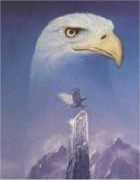
|
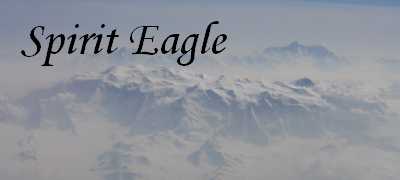
|
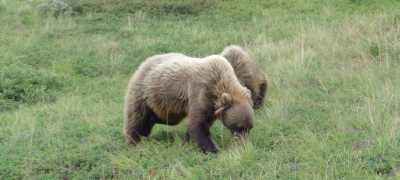
|
 |
 |
 |
 |
Alaska Flight - 2004
Denali
Friday, July 23 Tok:
After six days of peace and quiet and solitude the noise and bustle of the campground was a rude awakening. It didn’t quiet down until midnight and I was ready to go to bed at 8:00. I was not a happy camper. I woke up at 6:00 but didn’t actually get up until almost 7:00 since Jim was still sleeping peacefully. We had coffee and a slice of logan bread before hitting the long rough road to Chitina. It was a nice morning so we stopped to admire a couple of distant glaciers. The mountains were big and beautiful. At Chitina, to celebrate safely negotiating the McCarthy Road with all tires and windows intact (a near miracle from what we heard) we stopped at the same tiny café we visited last Saturday for a second breakfast. It was most welcome.
Then we stopped to return the bear canisters to the park office in Copper Center and look for a laundromat. Our hiking clothes practically could walk by themselves, they were so stiff with salt and dirt. So we stopped at a very busy little laundry in Glenallen where we were also able to buy a few groceries – bread and cheese and fruit.
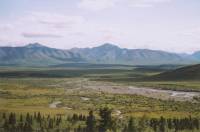
We spent the afternoon driving the Tok Cutoff along the north side of Wrangell St. Elias National Park. There were storm clouds all around, big, black and dramatic, so we had only partial views of the mountains of the Wrangell Range. Mt. Sanford and Mt. Drum are glacier-capped volcanoes that are visible for many miles – one is 12,000’; the other 16,000’. They are beautiful, even when covered in clouds. For the rest, we saw many miles of black spruce and aspen-covered hills, lots of ponds and rivers, an occasional cabin or business (mostly B&B’s and RV Parks), some rough road (paved, but with fresh gravel stretches) and lots of RV’s.
The driving is very straightforward as there are few places to stop, just a few rest stops and views, but mostly it’s open two-lane highway through forest and mountains. It was a nice afternoon. So far all the clouds have brought only scenic interest and little rain. The drive though the Mentasta Range was really beautiful. The ridges rise to about 6000’, about 4000’ above the highway. The rock is gray and red, the slopes covered in various shades of green, from the very dark spruce to sunlit aspen to the medium greens of the alder and willows. Some of the ridges are rounded; others are jagged rocky spines. It is very wild country. We saw few signs of people here.
About 5:30 we finally arrived in Tok after about 225 miles of relaxed driving from McCarthy. We stopped first at a used bookstore where we chatted a few minutes while buying a couple of books. We got recommendations for a local motel and restaurant, which worked quite well for us. After seven nights of camping out, a hot shower and clean sheets are very welcome. Dinner at Fast Eddies was excellent: prime rib and lasagna and salad bar. Smoke has moved in though, filling the air with the strong sweet smell of burning trees. I’m not sure just where the fires are, though from the smell and the burning in my eyes, it isn’t very far. (We read later that the fire in that area burned 850,000 acres – it was a big one.) Odd that we should have fire troubles two years in a row – last year in Canada and this year in Alaska.
Saturday, July 24 Fairbanks:
We had a good rest at the Golden Bear Motel. It was a nice, very friendly place. When we woke the air was clearer, with most of the smoke off to the east. We were heading west to Fairbanks. We heard that the smoke from those fires extended all the way to Arkansas!
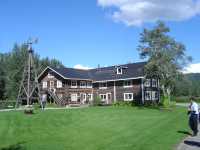
Leaving tiny Tok on the Alcan Highway we passed by part of the Alaska Range, rising tall and purple above us. We couldn’t see any of the really tall peaks; by the time they were visible, north of Delta Junction, the usual afternoon thunderclouds had moved in, covering the distant mountains. Most of the trip we paralleled the Tanana River – a wide fast one. We stopped at Rika’s Roadhouse which has been preserved as a historical site. It was an interesting site, with a lot of artifacts from the old days when roadhouses were an essential part of Alaska travel. Rika lived there until she was 94, so a lot was preserved, even after the roadhouse was no longer in business.
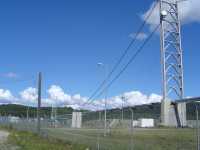
We also stopped at a spot where the Alyeska Pipeline crossed above the river. There were fences and security guards to protect it from sabotage. We ate a sandwich for lunch at a viewpoint above the Tanana. Again, we were just taking our time, moseying along. One disappointment was that a lot of the viewpoints are overgrown so there are only trees to be seen. When we were driving though the more scenic mountains there were no pullouts anywhere, then we had parking lots in abundance, but no views.
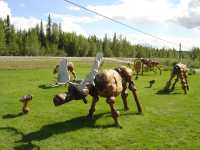
Farther up the road we stopped for a free ice cream cone at the Knotty Shop, an interesting gift shop with large burl wood animals out front and good blueberry ice cream.
Still in tourist mode, we made a short stop at the visitor’s center at North Pole Alaska, but decided we weren’t enough in the mood to shop at Santa Claus House after all. So we headed on to Fairbanks, which is a small town spread out over a big distance.
Touring options were limited by the time we arrived at 4:00 so we decided to visit the University of Alaska Museum which had an interesting mix of native artifacts, stuffed animals (bears, birds, etc.) a mummified 30,000 year old blue bison, pioneer photos, information on coal mining, the Alaska pipeline, and the aurora borealis with contemporary Alaskan art scattered about. It wasn’t a very big place, but it was well set up. We also attended a short talk on Alaska bears (black, grizzly and polar.)
By then it was dinner-time so we ate a pizza while pondering our next step. Since we’ll be camping for the next few nights, we decided to go for a motel, if we could find a room at 8:30 on a Saturday night. The first we called was full, but the next two had rooms, at typical outrageous Alaska prices. We found a couple of cheap places in the guidebook, but driving past them inspired no desire to stay there. Although we didn’t travel very far today, only about 220 miles, we weren’t in the mood to keep going, so we picked one of the high-priced ones – a Best Western—and settled down for the evening.
Sunday, July 25 Denali:
Jim had a restless night, but I slept well enough. We took our time leaving, first eating breakfast, then checking email on the motel computer (the only time we did that in the entire trip.) We had a short drive today, only 125 or so miles, so we took our time. There wasn’t a lot to see, though we did have occasional views of Denali. It was too far to photograph, but close enough to recognize. For the rest there were rivers and ponds, lots of trees, some pretty mountains and a moose cow and her calf in a pond near the road.
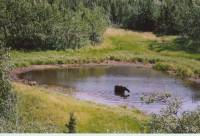
We arrived at the park at 1:00 – what a zoo! We stopped at the Visitor’s Center to pick up our various reserved tickets – campground and shuttle bus – then decided to see if we could get permits to backpack in the Park. The units we wanted were full, but we did get a couple of nights near Polychrome Mountain. We miscounted the days and requested one extra day, but it will serve as cushion if we have trouble in the backcountry. Getting a permit is interesting. They limit the number of people in each section of the park to preserve the sense of wilderness. The main part of the park is divided into 43 units that allow up to 8 people a day in each unit. There are other more remote areas that don’t limit hikers, but they are a long way back. The more popular ones fill up early. If you are willing to wait, you can eventually get what you want, but some of us don’t have the time to play with the system of starting with one area then moving on to the one you really want a day or two later. If you can’t wait, or don’t have a clue what you want, you go to a book that briefly describes each unit, listing attractions (views, bears, Dall sheep) and challenges (steep climbs, willow, river crossings, scree, glaciers, etc.) It isn’t all that helpful as it is so abbreviated. You have to understand the code, and we only had half a clue, based on our previous hike. We did know to avoid anything that listed willows prominently. It is a time consuming process trying to figure out what is available that meets your abilities. The backcountry staff weren’t at all helpful, they just left us alone to figure it out. But then, I didn’t ask for help either. They were surprisingly busy. A lot of people wanted to backpack in the Park. There was a required video on dealing with bears, camping rules, etc. and a free bear canister to be checked out. Then we needed to get maps for the area we would be hiking and another bus ticket on the camper bus out to the backcountry unit we will be hiking (the regular buses don’t have room for packs).
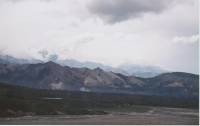
Finally we escaped to go out to the campground to pick out our site for the next two nights. Riley Creek is a nice campground with lots of trees and a sense of privacy. Most people are in RVs – in fact, I think we are the only tent on our row. We finally ate lunch at 3:00 and then headed out to go for a short walk, only to find the trailhead parking area completely full. So we kept on driving up the park road as far as cars are allowed – about 15 miles – to the Savage River area. We enjoyed the hills and mountains and looked in vain for wildlife. Denali was covered with clouds at the only overlook where you can see the mountain on a good day. Our only wildlife of interest was a falcon chasing a gull.
On the return we stopped at the trailhead and walked about three miles. We didn’t climb all the way to Healy Overlook, it was just too late for that. From there we went out to dinner – beer and a burger – before returning to our campsite. It was a nice bar and grill, with an outdoor balcony with a view of Mt. Healy. As usual, we ate too much. Despite our days in the backcountry, we’ll end this trip much fatter than we started. Too much time is being spent sitting in cars, buses, boats and planes. I enjoy the lackadaisical touring, but we’re not burning many calories watching the world go by at 60 mph, even stopping as often as we do.
Today I got a bit stressed, feeling the pressure of too many choices and not enough time. This trip seemed so luxurious, having 18 days to play with, but it still isn’t nearly enough time to do all the things I would like to do. Yesterday in Fairbanks we missed the boat trips on the river by arriving in town too late in the day. (Last boat was 4 pm, first one today 10 am – bad for us.) Today I hoped to do a rafting trip, but after spending two hours in the visitors’ center dealing with permits, that was no longer an option, not when I wanted to do some walking too. We wanted to spend a few days in the backcountry here, but it will end up being only a day and a half, between transportation out to the site and the need to drive a few miles south after our trek in order to keep our drive to Seward manageable. Although we knew the distances in Alaska were big, it is different to actually deal with long drives every day, even when the drives are as nice as they are.
We are seeing a lot of the country – Anchorage to McCarthy to Tok to Fairbanks to Denali to Seward to Homer - but it all leaves too little time to actually hike and sightsee when we are in each area. Here at Denali we are taking an all day bus trip out to the visitors center at Eielson, about 60 miles in. Because of stops for wildlife that takes 8 hours. Getting out to our backpacking area will take about 2 ½ hours each way. The hope is that we’ll see either bears or wolves along the way, but reality is, who knows?
I wish we had more time for our backpacking trip. Bushwhacking is always iffy. We had considered going to Denali State Park south of here if we weren’t able to get permits in the national park. There is supposed to be real trail and superlative views of Denali from Kesugi Ridge on a clear day – but the forecast is for clouds and showers, so it is unlikely we would get the views we would like. Our backcountry trek here will be a bit more wild, I think. There is no trail where we are going – just cross-country make-it-up-as-you go Alaska-type hiking.
Monday July 26 – Denali:
We played tourist today and had a terrific experience. We rode the green shuttle bus from the Main Visitors Center to the Eielson Visitors Center – about 60 miles each way. It took eight hours round trip.
First we woke up early and had the question of what to do until the bus took off. Our reservation was for 10:30 and we were up at 6:30. So we ate breakfast, visited the camp store, drank a latte there, went over to the visitors center, watched a very nice slide show on the park, watched a short video on the building of the park road and finally, eventually got on our ‘tour’ bus. It is a converted school bus and not one of the fancy Natural History tours (that cost twice as much and go 1/3 the distance) but instead what they call a shuttle bus. You can get on and off whenever you want and just flag down another bus later, if you want. Our bus was full – 46 people – of all ages and nationalities. There was a couple from Holland, four people from France and a retired school principal from Colorado and her friend who had just moved to Alaska in our immediate vicinity. We all kept our eyes open for wildlife. The bus will stop whenever anyone sees anything so everyone can watch and take pictures.
Today we were lucky. First we saw 14 Dall sheep grazing high above us. Then a black wolf crossed a bridge ahead of a bus coming the other way, so we watched as he trotted up a side creek. Then we spotted a bear high on a hill above the road. Then we saw various caribou on hills all around. Then we spotted (with the driver’s help – they know all the hot spots) a couple of fledgling gyrfalcons on a rocky outcrop near the road and later another falcon being chased by a gull. Then we saw three cow caribou and about a mile farther a calf, all alone, running the wrong way.
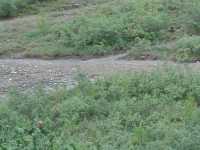
Then there was a big fat grizzly down below us who was being watched carefully about ten yards away by another black wolf. The bus driver said it was the alpha male of a pack with four cubs, one other having been eaten the week before by a grizzly.
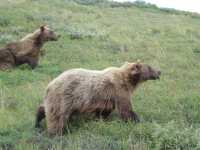
Shortly after that we ran into a female grizzly with a two year old cub, both intently grazing on blueberries. We watched them for about 20 minutes as they were very close to the road. Then Jim and I saw what was probably another bear, but the bus didn’t stop in time for us to identify it for sure. Then came a very large golden colored male bear, chasing ground squirrels. Finally a young golden eagle was spotted being pursued by two angry gulls. There were a few other birds (plover and ptarmigan) and arctic ground squirrels as well.
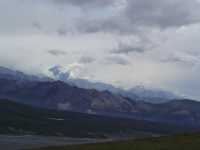
At that point, we stopped to turn around for the return drive. Whew! That was much less intense. We saw mama bear and her cub again and one lone bull moose deeply buried in a patch of willows. He had an 11-point rack. The rest of the time was spent looking at beautiful scenery and listening to our neighbors’ conversations. It was a cold, gray, windy dusty day. We stopped for a bathroom break every hour or so, so we were able to stretch our legs a bit.
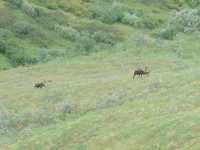
The land was mixed: green rolling hills, big mountains in many colors – red, orange, pink, gray and white – some glaciers, wide braided rivers, and even a distant and mostly cloud covered view of Denali from Eielson. We took a lot of pictures, though most of our wildlife viewings were too far away for good pictures. We got some good bear pictures and probably one or two of the caribou. Fortunately we carried binoculars, so we were able to see a lot that we couldn’t photograph. The Dutch gentleman had a 77 mm lens on his digital camera; his pictures were incredible. He would show us what we were looking at, better than we could see through the binoculars. One great photo was a close up of the bear’s nose, making it look as if she was only a few inches away, instead of the 20 or so feet she was in reality. His pictures of the gyrfalcons were also good. Evidently they are quite rare, so we are lucky to have seen them. Because of the weather no one got off the bus at all. We returned with the same number of people that started. Several people fell asleep for the last hour, when the chances of seeing wildlife were less. (The farther in you go, the better.)
We came home to pizza and packing up for tomorrow. It was tiring sitting all day, but exciting seeing so much wildlife. Six bears and two wolves – wow!
Jim:The last several days were “different” - we were back in “flatland tourister” mode. We drove back out the 59 miles of “bad road”, returned the bear cans to the Park HQ, and spent a couple days exploring Alaska. We drove to Tok (pronounced “Toke”), then to Fairbanks, stopping along the way to explore the country and some of the local attractions. Like the University of Alaska “Museum of the North” and the town of North Pole, AK. We even got a couple showers – and more than a few meals.
Eventually we started to close the circle and headed for Denali. It was “almost” funny – as we drove south from Fairbanks, we could see Denali clearly, but it was too far away to get a good picture. By the time we got within range for a good picture, the haze had closed in and there was no ”good picture” (of Denali) to be taken.
We stayed at Riley Campground at Denali for a couple nights, taking the “tourist” bus out to Eielson one day. It was a wonderful trip – 8 hours long, but well worthwhile.. The tourist bus stops for wildlife – and we saw moose, caribou, wolves, gyrfalcons and grizzly – among others. As well as a LOT of great scenery. And we got pictures. Lots of pictures. But still no “good” pictures of Denali itself because the weather had closed in.Tuesday, July 27 – Denali
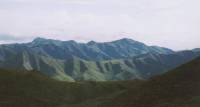
Today we set out for our overnight backpacking trip into the park. We ended up going to Unit 31, which is behind Polychrome Mountain. Yesterday we were able to figure out where to start and end the trek based on the maps and what we saw when we passed the area on the bus. There are rivers on both sides of the section and some steep scree in the middle, so it was good we got a chance to scope it out.
We caught the 8:30 camper bus after another very peaceful night at Riley Creek Campground. That was a nice campground. We didn’t actually leave until 9:00. I don’t know why, but that seemed to be normal. The driver was very gruff, explaining that this was a camper bus not a tour bus and while he would happily stop for wildlife sightings, don’t expect him to talk cheerfully throughout the drive. He was a curmudgeon. There were about eight backpackers on the bus; most of the rest were heading out to the campground at Wonder Lake (about a 5 ½ hour drive) while a few just wanted to do a day hike and planned to catch a bus back later.
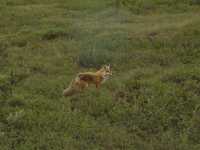
We didn’t drive out as far as yesterday (only about 2 ½ hours) so we didn’t see as much wildlife, though we still saw three caribou (two silhouetted against the ridgeline), a bull moose, a red fox digging up ground squirrel holes, and a two year old bear cub walking up the road. The driver said it was too young to be on its own and probably wouldn’t survive the winter. Speculation among park staff was that it might belong to the sow we saw yesterday but this one got separated from the pair earlier this summer. This cub isn’t eating enough, evidently. It likes to play, not search for food. It was very nervous and ran away quickly.
At the Polychrome rest area we left the bus and hiked over a hill and down a draw behind the bathrooms. I soon spotted three Dall sheep on a hill above us. They were too far away to photograph well, but it was fun to see them again, especially since the ones we saw yesterday from the bus weren’t there today. We started out easily, following ‘social trails’ down the valley. This area isn’t really trailless. There are use paths made by other hikers and wildlife. If you can figure out the logical way to go, sometimes you can find a trail that makes walking easier through the willows and alder. Then we ran into a big pond that blocked the valley. We climbed above it, but soon ran into a major rockslide area. Getting down and past that was tricky. Later we climbed up to a gap in the ridge above the valley and had lunch in a grassy patch, looking out over our next mile or so of hiking. We spotted two backpackers on the hill above us. They had come a different way and would have a very steep descent to the valley below. We don’t know if they were on the bus before ours or the one after. We went down to a stream, wallowing in willows that were very dense and very tall.
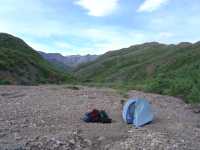
Eventually we climbed above the brush to a ridge which we were able to follow for quite a while, climbing steeply. I saw fresh caribou tracks and looked around. Sure enough, two bulls were grazing in the valley below us. The wind was fierce, but I really enjoyed climbing the ridge. We scared up a huge flock of ptarmigan – about 15. Like grouse, by flying up so suddenly they scared us as much as we scared them. Finally we reached a wide gravelly stream. There was room for the tent away from the water and nice views of the Cabin Divide on one side and Polychrome Mountain on the other. I got washed up in the stream, which felt great. The mountains all around were really beautiful – steep and colorful, dark red and blue and green. It was a good day. After supper we walked up stream a short way. Jim spotted white specks on the mountain above us. We watched them run across a knob and realized that there were at least three dozen Dall sheep on the ridge. Cool!
Jim:This morning we were back on a bus – but this time it was the camper bus and we had a permit for two days in the backcountry. The camper bus also stops for wildlife, but only if it’s really worthwhile. The bears, caribou, and fox must have classified as worthwhile because we spent some time watching them. And taking more pictures. We got off the bus at the Polychrome Overlook – and hauled our packs away from the road. Freedom – again. But we had a lot of trailless territory to cover. The usual (recommended) overnite hike from Polychrome is to circle East and get back to the road near the East Fork of the Toklat (about a 9 mile hike). So we headed West for a lot more miles and a lot more difficult hike. We were told there were 8 people in that particular sector. We only saw 2 – and we let them watch our taillights as we went over the far ridge headed for Cabin Creek and the Toklat. We made a very windy and somewhat rainy camp that night on an un-named river bar after a long day of climbing around and over a rockslide followed by some really rough bushwhacking. A short walk after dinner provided us with a long look at a herd of about 40 Dall sheep. Of course, neither of us had thought to bring a camera with us. But we got pictures of them the next morning after we climbed the ridge where they were feeding.
Wednesday, July 28 Denali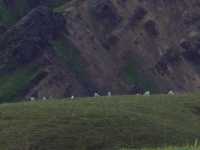
The winds were really fierce last night. We woke to sunshine though it didn’t last long. It rained just a few drops about 10:00, after we were in bed, but long before dark. We climbed the ridge out of our rocky canyon – about 500’ up, I think. We climbed to a spot where we could look for the Dall sheep we saw last night. On a nearby ridge we spotted five grazing and one more acting as sentinel high above. We dropped easily down to the next canyon, climbed another ridge, dropped and climbed again, and finally reached a wide valley, half a mile or more across, which we climbed gently to a pass. The willows weren’t too bad for the most part. Usually we could find a game trail across the patches. The ground underfoot had soft mossy tussocks and some swampy grassy areas, but mostly it was easy walking, just slow. On the far side of the pass it began to rain, gently. We descended along a stream that was a wide rocky gravel bed, rough underfoot but straightforward with no brush (a nice surprise.) We dropped gently for a couple of miles, following caribou and human footprints (probably the hikers we saw yesterday) to the Toklat River. That is a wide braided river, half a mile across, which we hoped to avoid crossing. The main channel moves very fast and the rocks underfoot are slick. There was, fortunately, a nice wide sand and gravel bench we could follow all the way to the road.
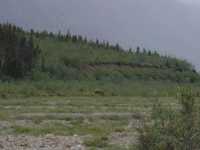
We did, however, discover an obstacle ahead of us: a light-colored female grizzly with a dark yearling cub. I spotted her when she was about 200 yards away. They were between us and the road we could see less than a mile ahead – what to do? We watched them play for a few minutes, then she started grazing in the bushes while her cub went exploring. We decided to try to skirt around her. She was next to the mountain, 50 yards away was her cub, 100 yards beyond that was the river. If necessary, we would go across the river, but if possible we wanted to avoid that option. So we walked along the river, singing in full voice. We didn’t want to surprise her and figured that if she knew where we were soon enough she would be less likely to get scared. We know she spotted us, because she moved closer to her cub, who was about half way between us. But she didn’t charge. We tried to keep one eye on the ground and the other looking around to see where they were. We felt a definite sense of relief when we were past them and she hadn’t come running. As we approached the bridge and the road, we saw two buses pull into the rest area across the river. One that was half empty got away, just as we walked up, but the other nearly full one waited and made room for us and our wet packs. It wasn’t a camper bus, but there was room, fortunately. I really didn’t want to wait in the rain any longer than we had to.
Despite the rain we managed a few more wildlife sightings: a female grizzly with two cubs, three caribou walking down a river bed, another caribou up on a ridge, some ptarmigan, 12 Dall sheep and finally a magnificent bull caribou that crossed the road right behind the bus and stopped to graze about 50 feet away.
I really enjoyed our short backpacking trip. We didn’t walk far – maybe eight or ten miles in all, but it was beautiful and interesting, even without all the bears. I love seeing bears – and wolves. (One disappointment – we never heard any wolves on either of our backpacking segments.) It is a very different kind of hiking. There was no set trail, not even a recommended route as we had for part of our Wrangell St. Elias trip. This time we just had a topographic map, a starting and ending spot and the rest was up to us. It was a good test of our map reading skills, but more than that, it requires constantly modifying plans based on the realities of the land we were walking through. A lot can be hidden in 100’ contours. We climbed some pretty steep hills and crossed a lot of 50’ gullies that really didn’t appear on the map. Then there’s the question of brush. A contour around a ridge may look easy on the map, but be impossible on foot because of the brush (or scree). When following a stream drainage, you don’t know until you get there whether it will be full of rocks, gravel, or willows. So whatever the plan, you have to be willing to modify it as the land requires. Physically it is hard and slow, but it is a lot of fun too. I really enjoy reading the land, looking for game trails, looking for good walking terrain, and climbing ridges just for fun and views.
We got back to the visitors’ center about 5:00. While we turned in our bear canister, we reported the bear encounter. (They closed two of the backcountry units a few days later because a hiker had a too close encounter with a female bear with cub. The hiker was lightly scratched, but not really hurt. Evidently he lay down too soon and she got curious. We don’t know if it was our bears or the ones we saw from the bus.) We went for dinner at the Overlook Bar and Grill again, then headed down the highway.
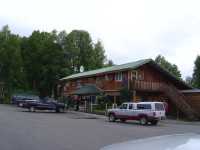
A few days ago it occurred to us that we were planning a very long day from Denali to Seward – over 350 miles. That wouldn’t allow any time for stops and lollygagging. So we decided to drive an hour or two tonight to cut down tomorrow’s journey. It rained off and on, so we didn’t get much in the way of views. There were steep mountains, a couple of rivers, some lakes and ponds, but mostly we saw clouds. Still it was a nice drive. I’m sorry I missed seeing a good view of Denali, but that’s not unusual.
We stopped at a little motel in Talkeetna, about 150 miles south of the park. It’s a funky little town, but the motel had one room left and it has a shower, so it will do.
Jim:Today started reasonably well, then turned cloudy and intermittently rainy about noon. Our only wildlife sighting was the Dall sheep at the top of the first ridge – until we got to the Toklat River and were working our way upstream toward the road. That’s when Ginny saw Mama Griz and her little one – close to the trees at the edge of the river bar - and between us and the road. We couldn’t pass her on the mountain side because that’s where she was most likely to run if she decided to leave where they were feeding and playing. Yep – I said playing – they were chasing each other around like a couple large (VERY LARGE) puppies. Passing them on the river side was chancy – the river bar is about two hundred yards wide where we were – but if she chased us the only way out was into the water – and the water runs fast and deep through there. So we really didn’t want to try to cross that river. Even waiting where we were for her to leave wasn’t a good option because we were upwind of her and it wouldn’t be long before she knew we were there and came to investigate. So – as that old saying goes – “L’audace, l’audace, toujours l’audace” -- we got as close to the water as possible and marched – and sang. Loudly. Junior had moved about halfway out from the trees toward the water, probably looking for something good to eat. And as we marched upriver serenading our furry friends, Momma moved out closer to us to join Junior and enjoy the unexpected and very ragged concert – and, incidentally, to protect Junior. Which left less than a hundred yard gap between her and the river through which we somewhat (largely?) nervously slid – all the while watching her watch us. And watch us she did – until we were a good half-mile upstream. Not a CLOSE encounter – but close enough.
We caught a bus out of the Park that afternoon, and drove south to Talkeetna that evening. Talkeetna is reputedly the town that inspired the TV program “Northern Exposure” even though the show was actually filmed in Washington. It’s a nice town – but really tourist oriented.
Home | Links| Trail Journals |
The Thruhiking Papers |Nutzotin | Denali | Kenai
Created: Fri, 03 Sep 2004
Revised: 30 Sept 2016Copyright © 2004-2016 Spirit Eagle